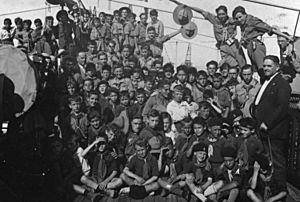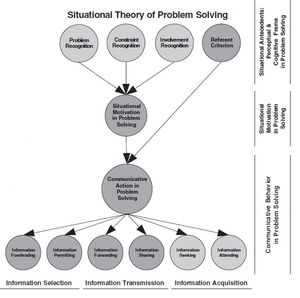Public facts for kids
In communication and public relations, the word public usually means a group of people. It's different from just a crowd or a meeting. You might hear about "the public" in subjects like government, how people think (psychology), or even how businesses sell things (marketing). The word can have many meanings, which can sometimes be confusing!
Contents
Where the Word Comes From
The word "public" comes from the Latin word publicus. This means "of the people".
Different Kinds of Publics
Social Publics
Social publics are groups of people who share the same ideas or hobbies. For example, fans of a certain sports team or people who love reading science fiction books.
Networked Publics
Networked publics are social publics that are connected by new technology. Think about groups formed on social media or online forums. These publics are a mix of the people, the technology they use (like social media apps), and their shared ideas.
Publics and Problems
The situational theory of publics helps us understand how groups of people (publics) form and act. It looks at how much people know about a shared problem and what they do to solve it. This theory helps explain when people will talk about ideas and when those ideas are important for solving a common problem.
Main Ideas of the Theory
This theory has five main ideas:
- Problem recognition: How much people know they have a problem.
- Constraint recognition: How much people feel their actions are limited.
- Level of involvement: How much a problem affects someone personally.
- Information seeking: How much new information people look for.
- Information processing: How much new information people understand and use.
How the Theory Started
This theory began with James E. Grunig's work in 1966. He first wrote about "problem recognition." Later, he added "constraint recognition" and "level of involvement." He also looked at how people search for and use information. In 1984, Grunig wrote a book called "Managing Public Relations." This book helped make the theory even clearer.
How the Theory Grew
Experts who use this theory created math rules (equations). These equations helped them sort different types of publics. They also showed how communication affects each public. Because of these rules, the theory became easier to understand and use. It is now common in school studies and professional work.
This theory is like studies about how people buy things, health messages, how media works, and government communication. But this theory has clearer main ideas. It also has a more developed way of learning and looking at things because of the equations. This means it can become more popular and include other smaller theories.
Expanding the Theory
Even though the theory is well-developed, it keeps growing. It has been used to explain why people join groups that want change (activist groups). It also helps us understand the different parts of problem recognition.
More research was done on how people see problems, limits, and their involvement. This research showed that if ideas are "internal" (inside a person's mind), communication can change them. If ideas are "external" (about things around a person), then those things need to change for a person's ideas to change.
In 2011, Jeong-Nam Kim and Grunig made the theory even bigger. They created the situational theory of problem solving.
- Hannay, Alastair (2005) On the Public Routledge ISBN: 0-415-32792-X
- Kierkegaard, Søren (2002) A Literary Review; Alastair Hannay (trans.) London: Penguin ISBN: 0-14-044801-2
- Lippmann, Walter. The Phantom Public (Library of Conservative Thought), Transaction Publishers; Reprint edition, January 1, 1993, ISBN: 1-56000-677-3.
- Mayhew, Leon H. The New Public: Professional Communication and the Means of Social Influence, (Cambridge Cultural Social Studies), Cambridge University Press, September 28, 1997, ISBN: 0-521-48493-6.
- Sennett, Richard. The Fall of Public Man W. W. Norton & Company; Reissue edition, June 1992, ISBN: 0-393-30879-0.
Images for kids






